Plant Science Research Weekly: November 1
Review: Celebrating 20 years of genetic discoveries in legume nodulation and symbiotic nitrogen fixation
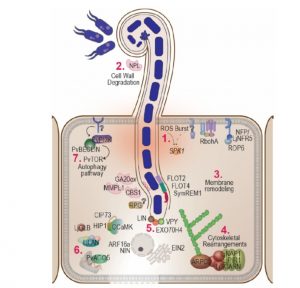 Legumes are important crops because they are protein-rich, as a consequence of symbiotic nitrogen fixation (SNF). In the past 20 years, through forward and reverse genetics more than 200 genes have been identified that are involved in this process, from recognition through nodule differentiation and metabolism. Roy et al. provide a comprehensive list of these genes from two model legume species, Medicago truncatula and Lotus japonicus and two crop species, Glycine max and Phaseolus vulgaris. While most SNF genes have homologs in non-legumes, many of these genes have evolved roles in SNF via gene family expansion and/or neofunctionalization, often resulting in nodule-specific expression. (Summary by Mary Williams) Plant Cell 10.1105/tpc.19.00279
Legumes are important crops because they are protein-rich, as a consequence of symbiotic nitrogen fixation (SNF). In the past 20 years, through forward and reverse genetics more than 200 genes have been identified that are involved in this process, from recognition through nodule differentiation and metabolism. Roy et al. provide a comprehensive list of these genes from two model legume species, Medicago truncatula and Lotus japonicus and two crop species, Glycine max and Phaseolus vulgaris. While most SNF genes have homologs in non-legumes, many of these genes have evolved roles in SNF via gene family expansion and/or neofunctionalization, often resulting in nodule-specific expression. (Summary by Mary Williams) Plant Cell 10.1105/tpc.19.00279
On the origin of oxygenic photosynthesis and cyanobacteria
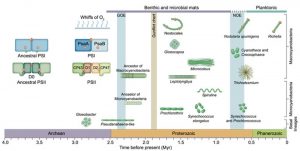 Photosynthesis occurs in several ways, only one of which releases oxygen as a product. As oxygen-breathing organisms, we are totally dependent on oxygenic photosynthesis, which is restricted to cyanobacteria and green plant plastids. In this review, Sánchez‐Baracaldo and Cardona examine how recent genomic data and improved evolutionary methods have helped to understand the evolution of photosynthetic reaction centers and how they combined to support oxygen production. The most recent age estimates of the photosystem I (PSI) and PSII gene families suggest that some sort of oxygenic photosynthesis was already established 3.0 billion years ago. Although oxygenic photosynthesis is often considered an innovation of cyanobacteria, it is likely that it preceded them and that the most recent ancestor of cyanobacteria was a prototroph already capable of water oxidation. Most of the cyanobacteria diversity appeared after the Great Oxidation Event (GOE; 2.3 – 2.4 billion years ago). (Summary by Cecilia Vasquez-Robinet) New Phytol 10.1111/nph.16249
Photosynthesis occurs in several ways, only one of which releases oxygen as a product. As oxygen-breathing organisms, we are totally dependent on oxygenic photosynthesis, which is restricted to cyanobacteria and green plant plastids. In this review, Sánchez‐Baracaldo and Cardona examine how recent genomic data and improved evolutionary methods have helped to understand the evolution of photosynthetic reaction centers and how they combined to support oxygen production. The most recent age estimates of the photosystem I (PSI) and PSII gene families suggest that some sort of oxygenic photosynthesis was already established 3.0 billion years ago. Although oxygenic photosynthesis is often considered an innovation of cyanobacteria, it is likely that it preceded them and that the most recent ancestor of cyanobacteria was a prototroph already capable of water oxidation. Most of the cyanobacteria diversity appeared after the Great Oxidation Event (GOE; 2.3 – 2.4 billion years ago). (Summary by Cecilia Vasquez-Robinet) New Phytol 10.1111/nph.16249
Dynamic control of plant water use using designed ABA receptor agonists
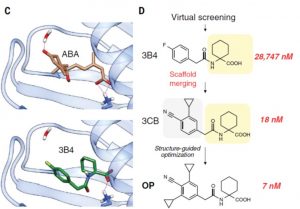 ABA is synthesized in response to water stress and promotes stomatal closure, thus decreasing transpiration. Crop yields can be increased by controlling transpiration early in the growing season, ensuring that soil water resources persist through the seed-set period. Building upon earlier studies, Vaidya, Helander et al. have identified a synthetic ABA agonist that binds tightly to ABA receptors to promote stomatal closure. Using structure-guided optimization drawing on crystal structures, they identified potential improvements, leading to the development of opabactin, which has a more sustained antitranspirant effect than ABA. (Summary by Mary Williams) Science 10.1126/science.aaw8848
ABA is synthesized in response to water stress and promotes stomatal closure, thus decreasing transpiration. Crop yields can be increased by controlling transpiration early in the growing season, ensuring that soil water resources persist through the seed-set period. Building upon earlier studies, Vaidya, Helander et al. have identified a synthetic ABA agonist that binds tightly to ABA receptors to promote stomatal closure. Using structure-guided optimization drawing on crystal structures, they identified potential improvements, leading to the development of opabactin, which has a more sustained antitranspirant effect than ABA. (Summary by Mary Williams) Science 10.1126/science.aaw8848
One thousand plant transcriptomes and the phylogenomics of green plants ($)
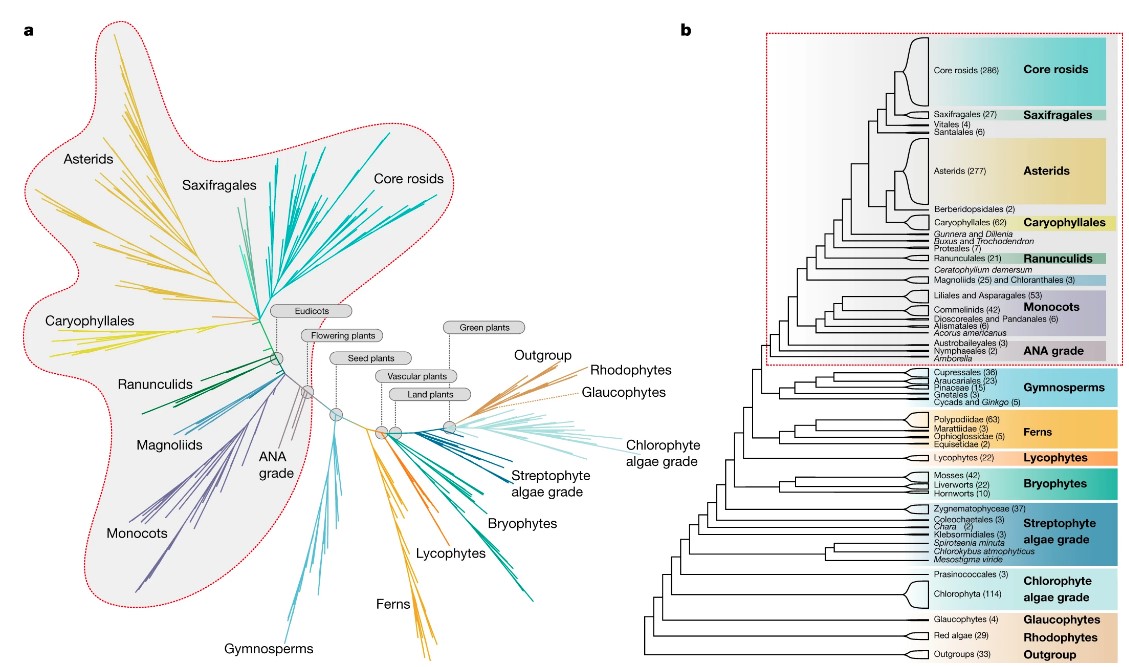 With a collaborative effort by multiple laboratories across the world, a database of transcriptomics data has been generated for 1124 species encompassing green plants, glaucophytes, and red algae. This extensive work referred to as onekp (one thousand plant transcriptomes) will aid in researchers to understand the functional diversity of gene families, species relationships among several others. This initiative has already led to multiple discoveries in the conservation and evolution of gene families in plant metabolism and development. The authors of this work have used single-copy genes to identify that expansion of gene families occurred before the evolution of green plant lineage and also the genome duplication that gives rise to complexity in gene function arise during the evolution of the green plant. Ultimately this large-scale data will enable researchers to utilize it for phylogenomics, species relation, gene functional analysis and also promote the development of new model organisms for studying gene functions. (Summary by Suresh Damodaran) Nature 10.1038/s41586-019-1693-2
With a collaborative effort by multiple laboratories across the world, a database of transcriptomics data has been generated for 1124 species encompassing green plants, glaucophytes, and red algae. This extensive work referred to as onekp (one thousand plant transcriptomes) will aid in researchers to understand the functional diversity of gene families, species relationships among several others. This initiative has already led to multiple discoveries in the conservation and evolution of gene families in plant metabolism and development. The authors of this work have used single-copy genes to identify that expansion of gene families occurred before the evolution of green plant lineage and also the genome duplication that gives rise to complexity in gene function arise during the evolution of the green plant. Ultimately this large-scale data will enable researchers to utilize it for phylogenomics, species relation, gene functional analysis and also promote the development of new model organisms for studying gene functions. (Summary by Suresh Damodaran) Nature 10.1038/s41586-019-1693-2
Replaying the evolutionary tape to investigate subgenome dominance in allopolyploid Brassica napus
 Following interspecific hybridization, one of the two parental genomes (aka subgenomes) tends to become dominant (more highly retained and expressed). What determines which of the subgenomes will become dominant, or is it random? To explore this question, Bird et al. made several crosses between Brassica rapa (A genome) and Brassica oleracea (C genome), recapitulating the several-thousand year old hybridization event that led to Brassica napus, an allopolyploid hybrid (AACC). The authors examined six resynthesized polyploid lines across ten generations with DNA-seq, RNA-seq, and Bisulfite-seq data to characterize gene dosage, expression, and methylation differences. Across independent lines and generations, the authors found a bias towards C subgenome dominance. They conclude that, ” ‘replaying the evolutionary tape’ in allopolyploids results in repeatable and predictable subgenome expression dominance patterns based on preexisting genetic differences among the parental species.” (Summary by Mary Williams) bioRxiv
Following interspecific hybridization, one of the two parental genomes (aka subgenomes) tends to become dominant (more highly retained and expressed). What determines which of the subgenomes will become dominant, or is it random? To explore this question, Bird et al. made several crosses between Brassica rapa (A genome) and Brassica oleracea (C genome), recapitulating the several-thousand year old hybridization event that led to Brassica napus, an allopolyploid hybrid (AACC). The authors examined six resynthesized polyploid lines across ten generations with DNA-seq, RNA-seq, and Bisulfite-seq data to characterize gene dosage, expression, and methylation differences. Across independent lines and generations, the authors found a bias towards C subgenome dominance. They conclude that, ” ‘replaying the evolutionary tape’ in allopolyploids results in repeatable and predictable subgenome expression dominance patterns based on preexisting genetic differences among the parental species.” (Summary by Mary Williams) bioRxiv
Early origin of miRNA-SPL module in reproductive development revealed by liverwort
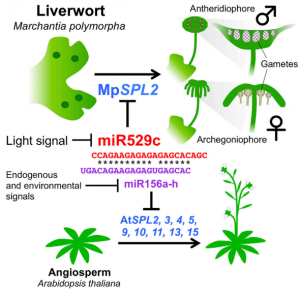 In Arabidopsis and other angiosperms, transition to flowering is controlled by a regulatory module that includes transcription factors from the SPL family and a miRNA miR156 targeting them. Marchantia and bryophytes do not make flowers, but there is an equivalent module that includes miR529c and a single target, Mp SPL2. Tsusuki et al. show here that a loss-of-function miR529c or a miRNA resistant version of Mp SPL2 produces functionally ectopic sexually reproductive organs, even in the absence of far-red light, the environmental signal required for the transition in the wild-type. Interestingly, Mp SPL2 knock-out plants can produce gametangiophores under proper environmental conditions. Analysis of gene expression suggest the module is important for the reproductive transition under far-red light conditions, but it is not essential for gametangia development. There are still open questions about how this signaling network interact with other regulators as BONOBO and phytochromes. This work supports the idea that floral transition in angiosperm and vegetative-to-reproductive transition in liverworts are homologous developmental processes with common regulators conserved across land plants. (Summary by Facundo Romani) Curr. Biol. 10.1016/j.cub.2019.07.084
In Arabidopsis and other angiosperms, transition to flowering is controlled by a regulatory module that includes transcription factors from the SPL family and a miRNA miR156 targeting them. Marchantia and bryophytes do not make flowers, but there is an equivalent module that includes miR529c and a single target, Mp SPL2. Tsusuki et al. show here that a loss-of-function miR529c or a miRNA resistant version of Mp SPL2 produces functionally ectopic sexually reproductive organs, even in the absence of far-red light, the environmental signal required for the transition in the wild-type. Interestingly, Mp SPL2 knock-out plants can produce gametangiophores under proper environmental conditions. Analysis of gene expression suggest the module is important for the reproductive transition under far-red light conditions, but it is not essential for gametangia development. There are still open questions about how this signaling network interact with other regulators as BONOBO and phytochromes. This work supports the idea that floral transition in angiosperm and vegetative-to-reproductive transition in liverworts are homologous developmental processes with common regulators conserved across land plants. (Summary by Facundo Romani) Curr. Biol. 10.1016/j.cub.2019.07.084
Challenging current interpretation of sunflower movements
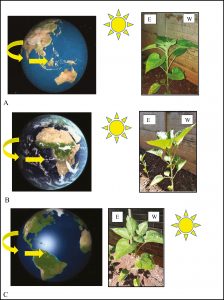 Plants are vigorous and sensitive organisms that can move various organs: leaves, shoots, tendrils, flower petals and roots. Movements in plants are usually regarded as a response to an environmental stimulus, such as light, temperature, or gravity. However, plants also are capable of autonomous, endogenous movements without apparent stimuli, and these movements can also exhibit a specific rhythm. Sunflower movements are generally described as heliotropic, with leaves and flower heads that track the sun during the day, regulated by an internal rhythm of gene expression. In this paper the authors took the generally believed idea that “sunflowers track the sun” with a grain of salt because the rotation of the earth around its own axis, gravity and gravitation are always not taken into consideration. The authors discuss the various ways that heliotropism and gravitropism have been defined, dispute the notion that sunflowers follow the Sun’s movement (they observe that the sun is fixed in space, whilst the plant is fixed on a rotating Earth), and how gravity contributes to resetting the position. The authors suggest that phototropism is a better explanation for sunflower movement. (Summarized by Francesca Resentini). J. Exp. Bot. 10.1093/jxb/erz381/5554344
Plants are vigorous and sensitive organisms that can move various organs: leaves, shoots, tendrils, flower petals and roots. Movements in plants are usually regarded as a response to an environmental stimulus, such as light, temperature, or gravity. However, plants also are capable of autonomous, endogenous movements without apparent stimuli, and these movements can also exhibit a specific rhythm. Sunflower movements are generally described as heliotropic, with leaves and flower heads that track the sun during the day, regulated by an internal rhythm of gene expression. In this paper the authors took the generally believed idea that “sunflowers track the sun” with a grain of salt because the rotation of the earth around its own axis, gravity and gravitation are always not taken into consideration. The authors discuss the various ways that heliotropism and gravitropism have been defined, dispute the notion that sunflowers follow the Sun’s movement (they observe that the sun is fixed in space, whilst the plant is fixed on a rotating Earth), and how gravity contributes to resetting the position. The authors suggest that phototropism is a better explanation for sunflower movement. (Summarized by Francesca Resentini). J. Exp. Bot. 10.1093/jxb/erz381/5554344
Postdocs’ lab engagement predicts trajectories of PhD students’ skill development
 When considering the traditional structure of mentorship in doctoral programs, it is easy to credit the doctoral advisor as the primary expert and liaison to their graduate students in a mentorship strategy known as the cognitive apprenticeship model. Contrary to this strategy is the cascading mentorship model, in which senior lab members at every stage contribute to mentoring junior lab members. Although mentorship is often only explicitly part of the job description for PIs, Feldon et al. found that participation in mentorship by postdocs and senior graduate students can predict students’ learning trajectory, whereas interactions in the lab with PIs have no bearing on students’ skill development. They followed 336 PhD students over the course of 4 years and measured their development through scoring sole-authored writing samples on 12 target skills to track their year-by-year growth and collected survey data annually regarding the structure and mentorship style of their individual labs. They found that the best predictors for positive skill growth in students were interacting with senior graduate students through discussing primary literature and holding laboratory discussions that include senior grad students and postdocs. PI engagement in the lab can not predict skill development or trajectories at all. This study shows that postdocs and senior graduate students are providing more mentorship services than traditionally expected and supports the promise of the cascading mentorship model in producing favorable outcomes compared to the cognitive apprenticeship model. (Summary by Rebecca Hayes) Proc. Natl. Acad. Sci. USA 9 https://doi.org/10.1073/pnas.1912488116
When considering the traditional structure of mentorship in doctoral programs, it is easy to credit the doctoral advisor as the primary expert and liaison to their graduate students in a mentorship strategy known as the cognitive apprenticeship model. Contrary to this strategy is the cascading mentorship model, in which senior lab members at every stage contribute to mentoring junior lab members. Although mentorship is often only explicitly part of the job description for PIs, Feldon et al. found that participation in mentorship by postdocs and senior graduate students can predict students’ learning trajectory, whereas interactions in the lab with PIs have no bearing on students’ skill development. They followed 336 PhD students over the course of 4 years and measured their development through scoring sole-authored writing samples on 12 target skills to track their year-by-year growth and collected survey data annually regarding the structure and mentorship style of their individual labs. They found that the best predictors for positive skill growth in students were interacting with senior graduate students through discussing primary literature and holding laboratory discussions that include senior grad students and postdocs. PI engagement in the lab can not predict skill development or trajectories at all. This study shows that postdocs and senior graduate students are providing more mentorship services than traditionally expected and supports the promise of the cascading mentorship model in producing favorable outcomes compared to the cognitive apprenticeship model. (Summary by Rebecca Hayes) Proc. Natl. Acad. Sci. USA 9 https://doi.org/10.1073/pnas.1912488116
Scientific societies advancing STEM workforce diversity: Lessons and Outcomes from the Minorities Affairs Committee of the American Society for Cell Biology
 Due to their stability and far-reaching support at all career stages, scientific societies are uniquely well-equipped to serve as trail-blazers in promoting the advancement of under-represented minority (URM) scientists. Scientific societies that participate in diversity initiatives are ubiquitous, however studies on the long-term impact of member participation in such initiatives are largely absent. In this paper, the authors highlight the successes of the American Society for Cell Biology’s (ASCB) Minorities Affairs Committee (MAC) throughout its decades-long history. To address the high attrition rates of URM researchers between the postdoc and new faculty stages, the ASCB MAC sponsors yearly career development workshops and developed both the Faculty Research and Education Development program to pair URM researchers with an experienced PI to mentor in grant writing and the Visiting Professor Program to match early career URM researchers with established professors. The MAC also provides travel grants to the society’s annual meeting for URM students and faculty that includes workshops in professional development, technical skills, and outreach training. Immediately following participation in one of the MAC programs, attendants answer an anonymous survey to gauge their success. To address the long-term outcomes, 98 past participants from 2006-2015 were re-surveyed and a majority reported attending multiple MAC programs, continuing in academic careers, serving as PI or co-PI on grants, and publishing papers or book chapters since participating. Attendees also reported positive psychosocial benefits, including feelings of belonging and support, which are especially important for URM researchers. The success of the ASCB MAC’s programming serves as a shining example of the long-term positive outcomes yielded from supporting URM researchers at the scientific society level, and will hopefully fuel development of similar programming across a wide range of societies. (Summary by Rebecca Hayes) bioRxiv
Due to their stability and far-reaching support at all career stages, scientific societies are uniquely well-equipped to serve as trail-blazers in promoting the advancement of under-represented minority (URM) scientists. Scientific societies that participate in diversity initiatives are ubiquitous, however studies on the long-term impact of member participation in such initiatives are largely absent. In this paper, the authors highlight the successes of the American Society for Cell Biology’s (ASCB) Minorities Affairs Committee (MAC) throughout its decades-long history. To address the high attrition rates of URM researchers between the postdoc and new faculty stages, the ASCB MAC sponsors yearly career development workshops and developed both the Faculty Research and Education Development program to pair URM researchers with an experienced PI to mentor in grant writing and the Visiting Professor Program to match early career URM researchers with established professors. The MAC also provides travel grants to the society’s annual meeting for URM students and faculty that includes workshops in professional development, technical skills, and outreach training. Immediately following participation in one of the MAC programs, attendants answer an anonymous survey to gauge their success. To address the long-term outcomes, 98 past participants from 2006-2015 were re-surveyed and a majority reported attending multiple MAC programs, continuing in academic careers, serving as PI or co-PI on grants, and publishing papers or book chapters since participating. Attendees also reported positive psychosocial benefits, including feelings of belonging and support, which are especially important for URM researchers. The success of the ASCB MAC’s programming serves as a shining example of the long-term positive outcomes yielded from supporting URM researchers at the scientific society level, and will hopefully fuel development of similar programming across a wide range of societies. (Summary by Rebecca Hayes) bioRxiv



